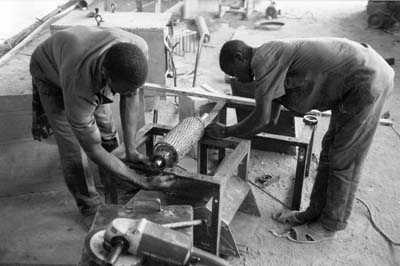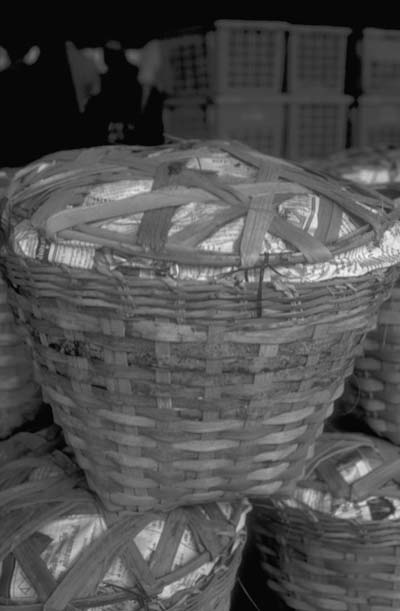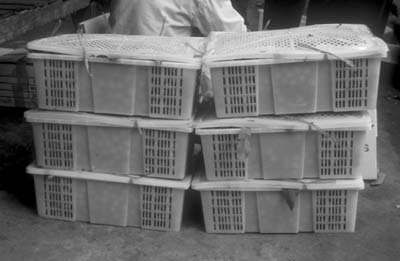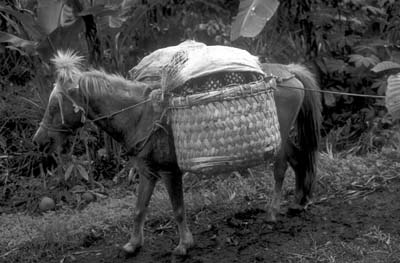Some supporting features should be in place before a new technology is adopted. Adequate supply of raw material, for example, is essential and probably represents the most frequent source of failure of village enterprises. These features and technologies are listed below and then discussed individually:
Many machinery companies have only one office in a country, and it may be difficult for a potential buyer to make a trip there or even to find it. Buyers are often not clear about what they require in the way of a machine.
FIGURE 16 Rural workshop in Nigeria making cassava graters.

It is up to the company to market its machines properly, to set up public demonstrations and field days and publish posters. A buyer who has a local sales office is fortunate indeed, because advice, training and maintenance support can be given.
Most machines need maintenance at regular intervals, which can be provided most easily by local machine shops. If the dealer who sold the machine is nearby, maintenance can be provided from that source. Spare parts will inevitably be needed. Maintenance needs can range from a simple weld to a new screen for a hammer mill or a rotor for a rice mill. Many components have to be imported, such as belts, bearings, chains and engine parts. Owners can make simple replacements, but ordering of parts and machining activities are the responsibility of the shop. Easy access to this facility is very useful though not essential and may only be needed once a year. These shops tend to grow up where they are needed.
Training is vital for the success of village enterprises. An owner or manager has to have a basic understanding of the business aspects as well as the technical implications. These are not natural skills, and they can be difficult to learn. Advice on such aspects as bookkeeping, future planning and payback periods is necessary to build a secure business with a good chance of success. The extension service in most countries is well positioned to provide these services.
Practical techniques and skills are more easily learned. Sales offices should be able to offer all the advice that is needed. Maintenance schedules, likely running costs and all other implications should be made very clear. Advice can also come from aid agencies, missionaries and governments.
Many small enterprises need at least a roof, if not a fully enclosed building. Most engines, for example, are designed to operate under cover. Tropical storms can cause damage, so engines should be mounted firmly and level on a concrete base. The roof can be made from local materials and should protect both operator and machine. Hand-operated equipment can of course be used wherever it is convenient; a special place for storage is all that is required. Dryers, threshers, cookers and roasters are often set up with a roof but without walls, allowing fumes and smoke to escape and letting the process continue even if there is rain. Rice mills, hammer mills and oil extractors are usually kept in locked buildings because of the need to protect valuable items such as bowls, sacks, tools, spare parts, raw material and finished products. Materials used for the building depend on the locality. Concrete blocks are the best choice if they are available, but in some villages a wooden or mud structure with a roof of banana leaves or palm branches may be the best option. If no concrete is available, the machine should be provided with a steel-bed frame and levelled as accurately as possible.
FIGURE 17 Galvanized-steel building for village hammer mill in Kenya.

Many processes depend on potable water, especially those that entail washing root crops and fruit with field dirt on them. If a well is nearby, then this problem is solved and the location of the process may be determined by the location of the well. River water is not usually as clean as well water, and if either well or river water is dirty, some form of filtration is required. Normally, 1 m depth of sand with a grain size of 0.3-0.8 mm would provide an adequate filtration bed, but further calculations and tests would have to be made to ensure that sufficient water could be filtered. A small cassava washing plant, for example, may need up to 4m3 of water per day, which calls for 4m2 of sand bed with 4m3 of sand and a suitable holding tank. The rate of filtration depends on the physical properties of the sand and its natural filtration rate. Tanks and elevated support structures would then need to be constructed, usually of galvanized steel or concrete. In some villages, this type of facility might need an engine-powered pump to provide the necessary water, as hand operation might be too laborious.
FIGURE 18 Locally made basket for taking produce to market in Thailand.

Packaging materials depend on the market. Local markets use traditional packaging materials such as woven bags, baskets and wrapping leaves. For selling to larger markets, however, or to markets in towns and cities, there may be a need for factory-made cartons, bags or plastic trays. Wrapping material can be of help, whether natural leaves and twine or factory-made paper. Factory-made cartons also help in determining the package size. Consistency of price per unit of weight helps give a buyer confidence. A well marketed product should be packaged for protection and preservation, and well presented, so that it will command a higher price. Some people will always prefer the local market type of presentation, even in the largest cities, but with the growth of shops and supermarkets, standards have risen all over the world and good marketing usually pays off.
Produce can be sold through entrepreneurs who own vehicles to take goods to market and provide the appropriate sacks and boxes. They are in a good position to reclaim containers from nearby towns and re-use them. When a farmer sells a product in a container, it is difficult to reclaim it or it may be non-returnable. This reduces the quality of container that the farmer can afford to lose, and so prices have to be increased to cover the cost of packaging. Used containers such as bottles for oil, juice and other liquids, sacks for rice and flour and baskets and boxes for dried spices are quite acceptable.
FIGURE 19 Returnable crates used for packaging produce to take to market in Thailand.

The main problems of returnable containers are as follows.
In the case of retail, the solution is often clear: buyers can either bring their own containers or set up a deposit system. A ready supply of second-hand or new containers can be a serious problem and needs to be addressed at an early stage.
Any business depends on its markets. Unless there is an existing demand, the market has to be created by persuasion. If no market exists for pineapple juice, for example, customers have to be persuaded of its virtues. The easiest approach is to build from a small business with each investment in new machinery fully justified by demand. In this case, one should simply make sure that the market is not oversupplied, or the producer will have to find new markets, requiring expansion and travel to other towns or villages.
Most produce is traditionally sold at the nearest market. Larger urban areas also attract street vendors and provide an opportunity for sales to shops. Sales of processed goods are most successful, however, if a regular outlet can be found. Information spreads quickly by word of mouth in most developing countries; if goods are satisfactory, there is less of a problem with marketing. A barter system may be necessary if a cash economy has not developed; goods may be exchanged in return for other goods or services. In some cases, customers bring their raw produce to a service machine and it is processed in return for a proportion of the goods. Maize or rice, for example, may be milled in return for 10 percent of the initial weight of the crop, and the milled product is returned in its original package. In some instances, customers receive their own crop back again; in others, they simply receive the appropriate weight of milled crop.
Marketing on a wider basis usually includes a packaging strategy. Cartons and bags may show the origin, weight and type of the contents. As a general principle, good packaging promotes the goods and provides enhanced protection and preservation. For sales in towns and cities this is a good approach, because the original processor is likely to lose contact with the final customer. If processors wish to build up a regular customer base, they must identify their produce clearly.
The first rule for a successful business is to know the market. The best product in the world will not sell if nobody knows about it. It is always easier to start a business with a product that is in demand. Once that part of the business is successful, other products can be launched on the back of a good reputation. A minimum level of business expertise is necessary for success, even at village level. At some stage, knowledge of office procedures, records, accounts and sales forecasting must be applied if the business is to grow. Other implications of a successful enterprise must be considered. If the introduction of a large new hammer mill, for example, puts all the other smaller millers out of business, it not a success for the village. It is important to know the potential for immediate sales in the village as well as for wider sales outside. This situation can often be helped by entrepreneurs who buy local produce with no intention of further processing: they will simply transport it to a bigger market for sale.
As a business grows, there is always the opportunity for widespread advertising through outlets such as radio, TV, roadside posters, portable exhibitions and field days. Extension services offer courses and help in these matters in most countries.
The start-up and growth of any business requires investment and risk. Success is not guaranteed, and worst-case scenarios must be considered before taking the plunge. Thousands of small processing plants and businesses thrive in developing countries, however, and make significant contributions to the quality of village life. There is room for many thousands more.
As markets grow, products tend to travel farther and farther. Many farmers transport their produce to market by bus. They will either stay at the market until the produce is sold or go home and return the next day. This approach has severe limitations for perishable items but not for processed goods, which do not suffer the same losses that fresh fruits and vegetables with poor packaging suffer on poor roads. Taxis, transporters and middlemen of various sorts can all play vital roles. Local markets can act as gathering points where transporters will gather goods and take them by truck to main markets. In this case, the transporter may be prepared to travel more than 100 km, which would be out of the question for a small producer.
FIGURE 20 Horse used for transporting produce to market in the Philippines.

When farmers can justify buying their own vehicles, however humble and whether as sole owners or in a cooperative, it heralds an independence that is a new stage in their development. This assumes the existence of roads that are passable for most of the year, although everyone will be aware of the danger periods. The need for transport has to come first, and the road will follow. Businesses tend to grow up along roads, so the presence of a road encourages further development; the initial stimulus, however, is often the availability of agricultural items from a productive area.
Bicycles are popular in many countries. Bags of produce can be strapped to a bicycle or loaded into its trailer, and distances about three times longer than with hand-carried loads can be covered. This extends the market considerably. Most countries have workshops that can service bicycles, so this is an attractive option, especially for low-volume processed goods such as spices.
For fully preserved items such as spices, dried fruit and possibly jams or high-valued items, animal transport may be satisfactory. Donkeys, oxen, camels and horses are all used to pull trailers or carry saddlebags, depending on the size of the load. Trailers can have spoked wheels for lighter loads or old motor-vehicle wheels for heavier loads up to 1 000 kg. Animals can cover distances up to 25 km, and in some cases will travel many days with a high-value commodity.
In developing countries, disposal of waste is not usually a high priority compared to obtaining sufficient food and earning sufficient income. Waste should, however, be turned into a byproduct whenever possible. Almost all agricultural waste material can be used in some way: peel, cores and any green waste from a plant used for making juice, puree or pulp can usually be fed to animals or composted to be put back on the land; similarly, waste from cereal plants such as husk, bran or germ can be fed to animals. Rice husk is probably the most inedible grain residue, although chickens and goats do pick over it. There are occasionally special uses that can be made of waste, such as selling the liquid that exudes from the shells of cashew nuts. Even dirty washing water can often be re-used after filtration to wash down floors and then as irrigation water.
For drying processes, burning waste as fuel is a practical way of enhancing the value of materials that may require disposal. Excess combustible biomass can be used for fuel, as has been widely practised by large-scale sugar producers, who burn the cane residue known as bagasse to dry sugar after it has been washed from the cane. In the same way, small-scale sugar expellers amass piles of mangled cane that can be burnt to dry the sugar. Rice husk can be used to dry parboiled rice and even to fuel the initial steaming. Residues from palm-oil presses can be used to sterilize the incoming bunches; sometimes the leftover nuts are burnt for sterilizing as well. Prunings, trimmings and old trees from plantations can all be used as a fuel for drying. In the early steam-powered oil mills, all these residues were used to heat the boiler of a steam engine that provided enough energy to drive the whole plant.
Residues can be used in other ways. Through the process of anaerobic digestion, most green organic matter will form methane gas if there is sufficient water available and the temperature is more than about 22oC. This is a very useful means of disposal and re-use of any inedible green matter, which yields up to 0.4m3 of gas for 1 kg of dry solids. The green waste is dumped into a tank filled with water to digest for up to three weeks. The resulting methane gas can be used for domestic cooking or even to power a diesel engine. The quantity needed to drive an engine may be too much for a small enterprise, but it should be possible to produce enough for domestic cooking. A small amount of equipment is needed, such as a tank with a sealing lid and some pipe work. Domestic waste is also digestible in this manner. In India alone, many thousands of small-scale digesters are used.
If methane production is impossible, any waste organic material can simply be kept in a special area and turned over with a rake or fork every few days. It will turn into compost that is useful as a soil additive and conditioner, returning nutrients to the fields. The heap should be kept in a loose but moist condition. Care should be taken to avoid creating permanent dumps for crop residues, because they can attract flies, create odours and breed disease.